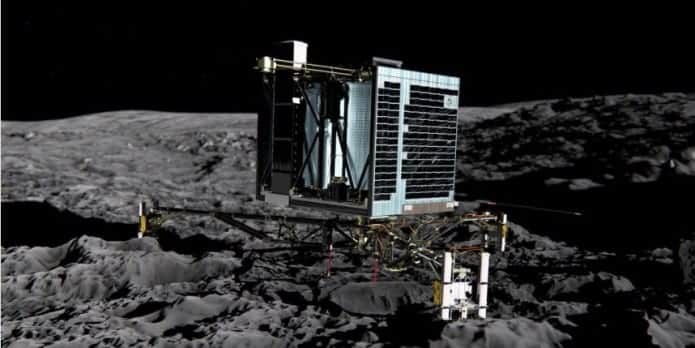Forgotten Philae robotic space lander surprises European Space Agency scientists by sending signals
A robotic space lander has shocked scientists by waking up and sending a signal to Earth, seven months after straying into the shadows of a comet where the officials feared it might be abandoned forever, the European Space Agency said on Sunday.
The European Space Agency said that it had received signals from the lander, named Philae, late on Thursday, when it began “speaking” with its team on the ground for the first time as it went into emergency hibernation following a poor landing on the comet in November.
Scientists think that the space probe is receiving increasing amounts of sunlight as the comet comes closer to the sun which enables its solar panels to generate the power required to send data.
ESA senior science adviser Mark McCaughrean told Reuters “There’s great excitement about it being back. However, we have to make sure that it is not the last croak of a dying cowboy”.
In the shadows, Philae’s solar panels received very less than the expected six to seven hours of sunshine per day after its batteries ran out several days after landing. It went into hibernation on November 2015.
After a new beginning, Philae “spoke” for 85 seconds with its team on the ground through its mothership Rosetta, which is orbiting the comet at a distance of about 6.5 km (4 miles). A detailed analysis suggests that the lander had been aware earlier but unable to make contact, ESA said.
Project manager Stephan Ulamec told Reuters that “It is very fascinating and we all are very happy to receive this signal. The lander seems to be perfectly healthy.”
Philae’s official Twitter account also came back to existence on Sunday, tweeting: “Hello Earth! Can you hear me?”. Scientists hope that samples drilled from approximately 3 to 5 km comet by Philae will open details about how the planets and possibly even life evolved. The rock and ice that make up comets protect ancient organic molecules like a time capsule.
In the month of November, the lander was released from Rosetta after a 6.4 billion km journey that took more than 10 years to complete its mission. This mission cost around 1.4 billion euros ($1.8 billion).
However, harpoons to secure Philae to the surface failed to set up and it bounced twice before floating to rest two hours later. Scientists worn the surface of Comet 67P/Churyumov-Gerasimenko for months with the hope that the lander would restart.
The environment at ESA blast from unhappiness to “unalloyed joy” when the first signal arrived, triggering a flood of midnight emails and emergency meetings among scientists keen to see what Philae would reveal, said McCaughrean.
Now the challenge is to review the state of the lander itself with scientists waiting for the next contact. ESA said that there are still more than 8,000 data packets in Philae’s mass memory that will provide information on what happened in the past few days.
Comets date back to the formation of the solar system some 4.6 billion years ago. Some scientists believe that comets delivered water to Earth when they collided with the planet eons ago.
McCaughrean said that “Comets are treasure chests of material from the birth of the solar system.”

